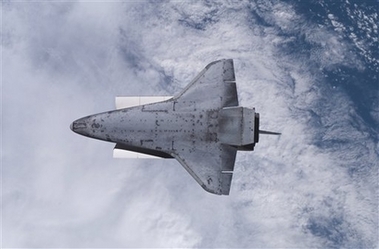NASA to look closer at troubling gouge
Updated: 2007-08-12 19:37
 This image provided by NASA shows a view of the Space Shuttle Endeavour as the STS-118 crew puts the spacecraft though a rendezvous pitch maneuver Friday Aug. 10, 2007, allowing the crewmembers on the nearby International Space Station to document the vehicle's thermal protection system condition. [AP] |
HOUSTON - NASA wants to get a closer look at a troubling gouge on the heat shield that protects space shuttle Endeavour's belly to determine if astronauts need to repair the 3-inch wound.
The space agency planned to spend several hours Sunday doing a detailed inspection of the 3 1/2-by-2-inch gash. It was caused by a piece of foam that came off the shuttle's external fuel tank during liftoff last week, striking tiles that insulate the ship from the intense heat of re-entry to Earth, NASA said.
The space agency is still trying to determine how serious the ding is and whether astronauts need to repair the damage during a spacewalk. That's less likely now that managers know the gash was caused by foam, not heavier and potentially more damaging ice like they initially suspected.
To gather more data, particularly the depth of the gouge, teacher-turned-astronaut Barbara Morgan and crewmate Tracy Caldwell will use the space shuttle's robotic arm and laser-tipped boom to sweep over the area. The process was expected to take about three hours.
Back on Earth, engineers and other experts were to continue reviewing radar launch imagery and photographs that were taken by the space station crew before the shuttle docked.
A grapefruit-sized piece of foam appears to have come off a bracket on the fuel tank, then bounced off a strut farther down and shot into Endeavour, said John Shannon, chairman of the mission management team. The brackets hold the long fuel feed line to the tank, and the struts connect the tank to the shuttle for launch. Ice tends to form near these brackets and cause the foam to pop off at liftoff.
Foam has come loose from the brackets on previous flights, Shannon said, and NASA is looking at how to redesign the apparatus to mitigate this problem.
"It's a little bit of a concern to us because this seems to be something that has happened frequently," Shannon said.
Directly beneath the damage is part of the aluminum framework of the starboard wing, which would provide additional protection during re-entry, Shannon said. He called that a lucky break.
Almost every mission in the 26 years of shuttle flight has ended with gouges of at least an inch in the thermal tiles that cover the belly. In one flight, nearly 300 dings that big were recorded.
The ship's belly is exposed to temperatures as high as 2,300 degrees Fahrenheit while passing through the Earth's atmosphere. Shuttle wings encounter even more heat, which is why the briefcase-sized foam that hit Columbia's left wing at liftoff was fatally damaging when left not repaired.
Since that disaster, NASA has equipped crews with tile repair kits. Depending on the extent of the damage, astronauts can slap on protective paint, screw on a shielding panel, or squirt in filler goo. These repairs could be made during a fourth spacewalk next week, but managers said they are less likely to resort to that option now that they know the damage was caused by foam. They learned this after examining video from cameras retrieved from Endeavour's booster rockets, which were towed back from the Atlantic.
In fact, if Endeavour had to make an emergency landing right now, NASA would take the chance based on all the risks, Shannon said.
Astronauts completed the mission's first spacewalk on Saturday, installing a new addition to the orbiting outpost. At least two more spacewalks are planned.
NASA hopes to keep Endeavour at the space station for at least seven days and quite possibly a record 10 days. The shuttle is equipped with a new system for drawing power from the station, and mission managers are expected to approve the extra docked days on Sunday.
|
|
|
||
|
||
|
|
|
|